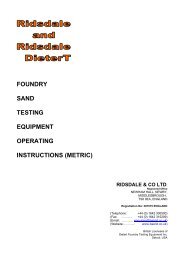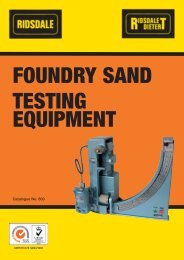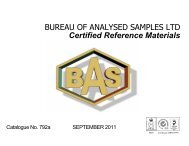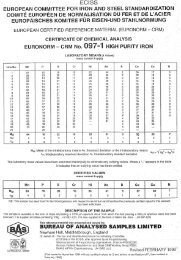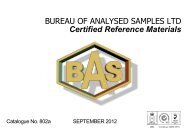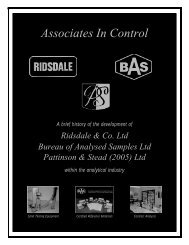AFS Foundry Sand Testing Equipment Operating Instructions Manual
AFS Foundry Sand Testing Equipment Operating Instructions Manual
AFS Foundry Sand Testing Equipment Operating Instructions Manual
- No tags were found...
Create successful ePaper yourself
Turn your PDF publications into a flip-book with our unique Google optimized e-Paper software.
RIDSDALE IMPACT PENETRATION TESTER (cont’d)IIITEST PROCEDURE (cont’d)(a)(b)Screw one of the two probes firmly into the probe holder at the end of the instrument.If the mould or core to be tested is expected to be very hard, turn the knurled knobclockwise as far as it will go to give maximum spring pressure on the hammer.Should the mould or core be relatively soft, the knurled knob should be turned anticlockwiseuntil it is in the fully extended position to give the minimum spring pressureon the hammer.By turning the knurled knob one full rotation, until the index mark is in line with thelongitudinal line on the body of the instrument, any one of five intermediate positionscan be selected. This means that the instrument may be readily reset to a predeterminedspring pressure between minimum and maximum for any particularapplication.(c)(d)(e)Place the point of the probe on the mould surface. Hold the instrument at rightangles to the surface and press the instrument firmly inwards until a definite impact isfelt. It is important that the spring loaded hammer in the body of the instrumentshould be responsible for forcing the probe into the surface and hence only sufficientpressure should be applied by the operator to release the hammer mechanism.Repeat this operation without withdrawing the probe from the surface and record thenumber of impacts necessary to bring the first one centimetre graduation mark levelwith the mould surface.Continue impacting the probe into the mould, maintaining it at right angles to thesurface, and record the number of impacts necessary for each centimetre of theprobe to penetrate the mould.NOTE:To avoid damage to the probe, care should be taken to keep the body of theinstrument in line with the probe during penetration.IVINTERPRETATION OF RESULTSIt is known that uniform hardening is not normally achieved from the surface to the interior ofa mould or core during the hardening process. It is generally desirable to strip a mould fromits box as soon as sufficient hardening has developed to avoid distortion or breakage. As arule the time required for this is much less than that for full uniform hardness development.By plotting the number of impacts per centimetre of probe penetration against the depth ofpenetration it is possible to assess the hardness at varying distances from the mouldsurface.Routine acceptance tests on cold self-hardening sand mixtures can be carried out with thisinstrument by assessing the number of impacts required to penetrate the probe a givendistance into the mould surface when the required sub-surface hardness for stripping hasbeen achieved.VRECOMMENDED SPARESPart No.Description2701 Graduated Probe.128



